The Role of Statins in Cancer Prevention and Treatment
Statins inhibit the activity of the rate-limiting enzyme in the cholesterolbiosynthetic pathway, HMG-CoA reductase, and are widely prescribedfor lowering plasma lipid levels. Several statins have antitumor effects inexperimental models, and observational studies suggest that this anticanceractivity in the laboratory may translate into effective treatments and/orpreventive strategies for certain human cancers. This paper reviews thelaboratory and clinical evidence that statins have anticancer activity, discussesthe possible mechanisms by which tumor growth may be inhibitedby this class of drugs, and outlines strategies for the evaluation of theseagents in the prevention and treatment of human cancers.
Statins inhibit the activity of the rate-limiting enzyme in the cholesterol biosynthetic pathway, HMG-CoA reductase, and are widely prescribed for lowering plasma lipid levels. Several statins have antitumor effects in experimental models, and observational studies suggest that this anticancer activity in the laboratory may translate into effective treatments and/or preventive strategies for certain human cancers. This paper reviews the laboratory and clinical evidence that statins have anticancer activity, discusses the possible mechanisms by which tumor growth may be inhibited by this class of drugs, and outlines strategies for the evaluation of these agents in the prevention and treatment of human cancers.
HMG-CoA reductase inhibitors (or "statins") are US Food and Drug Administration (FDA)- approved for treating hypercholesteremia. Members of this drug class currently available in North America are listed in Table 1.[1,2] Statins produce reductions in low-density lipoprotein (LDL) cholesterol of up to 60% by inhibiting the rate-limiting step in hepatic cholesterol biosynthesis and have been shown to decrease cardiovascular morbidity and mortality in both primary and secondary prevention studies (reviewed in [3]). Beyond lipid-lowering, however, the statins have effects on numerous other biologic pathways, suggesting that they may be useful for treating conditions other than cardiovascular disease (reviewed in [4-6]). For example, statins have antithrombotic and anti-inflammatory activity that may account for their apparent ability to decrease the risk of venous thromboembolism and ischemic stroke, prevent osteoporosis, and retard the progression of multiple sclerosis. In addition, they are generating much interest in their anticancer activity, which is the subject of this review. The pleiotropic activities of statins are summarized in Table 2.[1,5,7-14] General Information Over 76 million prescriptions for statins were filled in the United States in 2000, making statins the most widely prescribed drug class for lowering cholesterol and among the most widely prescribed of all drug classes. While they all competitively inhibit the enzyme HMG-CoA reductase, the six statins currently available in North America differ in their synthesis, structure, potency, metabolism, and pharmacokinetic and pharmacodynamic properties (Table 1). These dissimilarities may account for the observation that the individual drugs seem to have disparate anticancer activities.[15,16] Biochemistry
Lovastatin, a mevinic acid derivative produced by fermentation of Aspergillus terreus, was the first statin marketed in the United States for cholesterol-lowering. Pravastatin (Pravachol) and simvastatin (Zocor) are the two other fungal-derived, "natural" statins. Fluvastatin (Lescol) was the first entirely synthetic statin and has been followed by atorvastatin (Lipitor), cerivastatin, and rosuvastatin (Crestor). Cerivastatin has been voluntarily removed from the US market because of its association with a higher than expected number of fatal cases of rhabdomyolysis. All statins are competitive inhibitors of HMG-CoA reductase to prevent the conversion of HMG-CoA to mevalonate (Figure 1). Disruption of this step results in an overall decrease in the amount of cholesterol produced by the liver and, therefore, a lowering of plasma cholesterol levels. Although cholesterol is the most widely studied product, several key intermediate products of this biochemical pathway are also affected by statins. It is the inhibition of these intermediates that accounts for the panoply of biologic effects that statins have beyond cholesterol reduction.
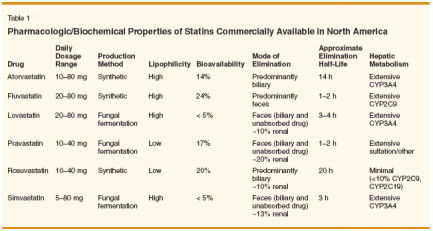
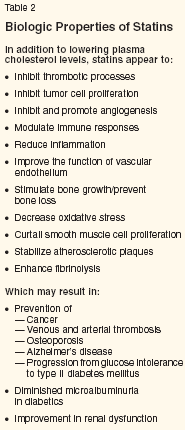
Products of the cholesterol biosynthesis pathway with particular relevance to oncology include geranylgeranyl pyrophosphate (GGPP) and farnesyl pyrophosphate (FPP), which are used by their respective transferase enzymes for posttranslational modification of certain cellular proteins. For example, Ras requires the addition of a farnesyl moiety for activity,[17] and targeting this farnesylation step with farnesyl transferase inhibitors is an active area of cancer treatment investigation. Similarly, Rho GTP-binding proteins are involved in cell signaling processes and require geranylgeranylation for activity.[18] Inhibition of Rho protein activity by disruption of geranylgeranylation is also a promising potential cancer treatment strategy and is discussed below. Pharmacology
The pharmacology of HMG CoA reductase inhibitors has been reviewed in detail recently.[1] The statins are orally administered and are variably absorbed from the gastrointestinal tract with bioavailabilities ranging from < 5% (lovastatin, simvastatin)to 25% (fluvastatin). The statins concentrate in the liver, where they reduce hepatic cholesterol synthesis, resulting in upregulation of hepatic LDL receptors, which in turn results in increased clearance of LDL cholesterol from plasma. Since statins concentrate in the liver, little drug circulates in plasma and that which does circulate is highly protein bound. Except for rosuvastatin, the statins are extensively metabolized in the liver to active (atorvastatin, lovastatin, simvastatin) or inactive (fluvastatin, pravastatin) metabolites. All statins are eliminated predominantly by biliary excretion into feces; however, the elimination half-lives vary considerably (Table 1). The statins differ in their solubility properties; pravastatin and rosuvastatin are hydrophilic, whereas the remaining members of the class are lipophilic. Pravastatin is unique among the statins in that it is not metabolized by the cytochrome P450 system and hence has fewer potential medication interactions than other members of the class. Toxicity
Statins have been used safely in millions of people worldwide, but cerivastatin was withdrawn from the US market after postmarketing surveillance revealed a higher than expected incidence of fatal rhabdomyolysis. Liver and muscle are the primary targets of statin toxicity. In large, randomized cardiovascular clinical trials, elevations of serum transaminase levels to greater than three times normal were observed in 1% to 3% of participants receiving statins (reviewed in [19]). No study, however, has demonstrated a significant difference between statins and placebo for serious hepatic adverse events. All statins may be associated with asymptomatic elevations of serum creatinine kinase or with symptomatic muscle injury (reviewed in [20,21]), but the incidence of these events is low (< 1% and 0.1%, respectively). Moreover, in four major cardiovascular trials involving over 50,000 participants, no significant differences in the incidence of muscle injury were observed in the statin and placebo groups. Rhabdomyolysis is a rare but potentially fatal complication of statin use. Cerivastatin accounted for nearly half of all reported fatal rhabdomyolysis cases through 2001 (31 of 73 total cases), and the rate of fatal rhabdomyolysis with cerivastatin was 16 to 80 times greater than that for any other statin. It must be noted, however, that these 73 statin-associated rhabdomyolysis deaths occurred in the context of nearly 500,000,000 statin prescriptions dispensed, indicating that serious muscle complications due to these drugs are rare. Moreover, the risk of muscle injury is highest when statins are administered concurrently with certain other medications that increase plasma statin levels, including fibric acid derivatives (eg, gemfibrozil), azoles (eg, itraconazole [Sporanox], fluconazole), erythromycin, and some immunosuppressive agents (eg, cyclosporine).
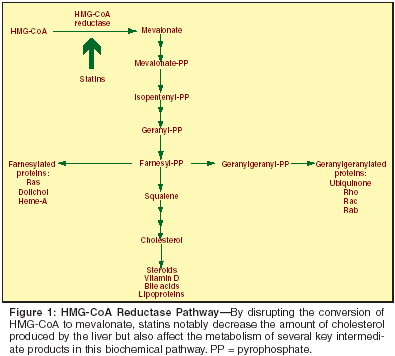
Do Statins Cause or Prevent Cancer? The results of toxicology studies in animals raised the concern early on that statins might cause cancer (reviewed in [22]), and a meta-analysis of cholesterol-reduction studies reported a small but nonsignificant excess of cancer deaths in participants treated with cholesterol-lowering agents.[23] As a result, later cardiovascular trials included cancer incidence as a secondary end point, and multiple epidemiologic investigations have been conducted to assess the possibility that statins might cause harm. Major human studies in which the effect of statins on cancer incidence has been evaluated are summarized in Table 3.[24-44] In general, statins are safe and well tolerated by most people who take them, and there is no persuasive evidence linking these drugs to the development of cancer in humans. Neither the increase in breast cancer cases seen in one study[26] nor the small increased incidence of malignancy in one elderly population[28] has been replicated in several larger investigations. Moreover, later metaanalyses and epidemiologic studies do not demonstrate an increased risk of cancer (Table 3). On the contrary, the preponderance of currently available data suggests that statins may prevent cancer. This was first hinted at in the Air Force/Texas Coronary Atherosclerosis Prevention Study (AFCAPS/ TexCAPS), in which lovastatin was compared to placebo for the primary prevention of cardiovascular disease, and a 50% reduction in new cases of melanoma was observed in the treatment group.[24] Results of subsequent case-control studies further support the hypothesis that statins prevent certain malignancies, including melanoma, and cancers of the breast, colon, and possibly prostate.[37-40,44,45] Do Statins Help Treat Cancer?Lovastatin and Brain Tumors
Lovastatin has been evaluated in a phase I trial in which the maximum tolerated dose was 25 mg/kg/d (in four divided doses) administered on days 1 through 7 of a 28-day cycle.[46] The dose-limiting toxicity was myopathy, which was preventable by treatment with ubiquinone (also known as coenzyme Q), a downstream derivative of mevalonate whose production is inhibited by statins (see Figure 1). One partial response was documented in a patient with a high-grade glioma among 88 patients treated in the study.
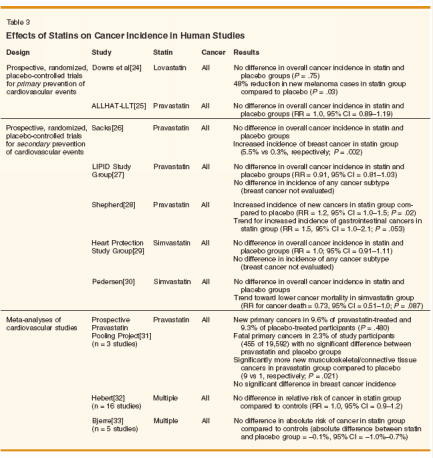
An ensuing phase I/II trial evaluated lovastatin alone or combined with radiation in patients with anaplastic astrocytoma and glioblastoma multiforme.[ 47] Patients with newly diagnosed tumors received combinedmodality treatment, and those with relapsed disease were treated with the statin alone. Cohorts of three patients in the combined-modality group each received a lovastatin dose of 20, 25, and 30 mg/kg/d for the first 7 days of 28-day cycles. No unexpected neurologic toxicity was observed at any lovastatin dose level. There were two minor and two partial responses in this group (response duration: 160-236 days) and no complete responses. In nine patients with relapsed tumors treated with the drug alone at a dose of 30 mg/kg/d using the same schedule, one patient had a partial response lasting in excess of 405 days, one had a minor response, and one had stable disease. Lovastatin was associated with little toxicity in this study, and no patient discontinued the drug due to adverse events. Although two patients experienced episodes of arthralgias (which readily responded to treatment with analge-sics), no patients developed myopathy.
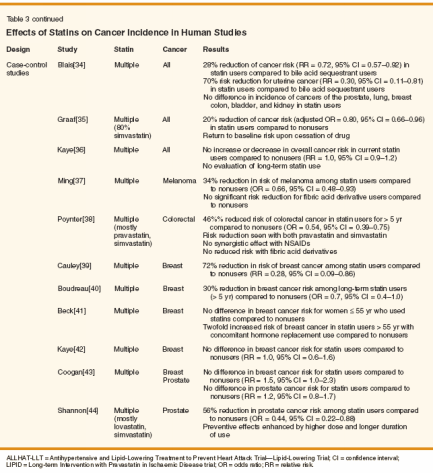
These studies suggest that lovastatin is well-tolerated at high doses and may have modest anticancer activity in high-grade brain tumors. By contrast, a phase II study of lovastatin (35 mg/kg/d for 7 days repeated every 28 days) in advanced gastric cancer demonstrated no responses among 16 patients.[48] Effect of Administration Schedule
Although it is likely that statins, like most anticancer agents, will be effective in some tumor types but not others, the intermittent administration schedule employed in the studies above may have been inappropriate and might lead to the abandonment of a promising agent prematurely. Laboratory investigations point to a growth inhibitory mechanism of action for statins in cancer (see below); thus, a continuous administration schedule may be preferred. For example, fluvastatin was administered daily for 14 days every 4 weeks in a phase I study with 12 pediatric patients with refractory solid tumors.[ 49] The maximum tolerated dose of fluvastatin administered on this schedule was 8 mg/kg/d, and despite the poor prognosis of this group of patients, there were 6 partial responses with two anaplastic astrocytoma patients remaining alive 22 months after initiating treatment. In another report, a patient with relapsed acute myelogenous leukemia (AML) treated with lovastatin, 40 mg four times daily continuously for 2 months, experienced a decline in the peripheral blast count, which persisted for an additional 3 months after stopping the drug.[50] Pravastatin and Liver Cancer
Pravastatin had anticancer activity when administered continuously to patients with advanced hepatocellular cancer.[ 51] A total of 91 eligible patients with advanced, unresectable hepatocellular cancer underwent transcatheter arterial embolization followed by treatment with oral fluorouracil (5-FU) for 2 months. The 83 patients who successfully completed the induction phase of the study were randomly assigned to receive pravastatin, 20 mg daily for 2 weeks followed by 40 mg daily until disease progression (n = 41) or no further therapy (n = 42). There were no significant differences among baseline patient characteristics in the two groups. The median survival in the pravastatin group was significantly longer than that in the control group (18 vs 9 months, respectively, P = .006), and in multivariate analysis, pravastatin was a significant factor contributing to survival (P = .005). Although there were no objective tumor responses in the pravastatin group, serum alpha-fetoprotein levels were significantly lower in the pravastatin group at 6 months and 1 year compared to the control group (P = .04 and P = .03, respectively). Likewise, the increase in maximal tumor diameter was smaller in the pravastatin group at 6 months and 1 year (P = .03 and P = .01, respectively), suggesting that pravastatin had a tumor growth inhibitory effect. Small Study in Rectal Cancer
The results of a small study suggested that statins may improve the rate of pathologic complete remission (pCR) in patients with rectal cancer treated with neoadjuvant chemoradiation.[ 52] Evaluable patients with rectal cancer undergoing resection with curative intent after receiving neoadjuvant chemoradiation (n = 348) were analyzed for statin use or nonuse. Nine percent of the patients used statins, and their tumor characteristics were no different from those of nonusers. At the time of resection, however, 7% of non- statin users were discovered to have metastatic disease compared to 0% of statin users. Moreover, the pCR rate for statin users was 30% compared to 17% for nonusers (P = .10), translating into a weak association between statin use and pCR in multivariate analysis (odds ratio for pCR with statin use = 2.1, 95% CI = 0.93-4.9; P = .07). Although this was a small, retrospective study that did not show a statistically significant anticancer effect of statins, when viewed in conjunction with the epidemiologic data suggesting that statins may have anticancer activity in colorectal cancer,[ 38] one must consider this a strategy worth investigating further. Antineoplastic Effects of Statins Numerous laboratory investigations in which tumor cell lines or tumorbearing animals have been exposed to statins have provided insights into possible anticancer mechanisms of these drugs (summarized in Table 4).[53-75] The weight of evidence suggests that the statins are predominantly growth inhibitory rather than cytotoxic. A key target for statins is posttranslational isoprenylation of proteins which is required for optimal protein activity as well as for correct localization within cells. Statins inhibit the formation of FPP and GGPP, which are used as substrates by their respective transferase enzymes for protein prenylation. Disruption of this important step in protein synthesis produces downstream effects in various pathways including apoptosis and cell differentiation, angiogenesis, coagulation, and proteasome activity. While this is summarized briefly below, readers are directed to several excellent reviews for more detailed treatment of this subject.[15,16,76] Effects on Apoptosis
Statins trigger apoptosis in numerous experimental cancer models including both solid tumor and hematologic malignancies (reviewed in [77]). Upregulated expression of certain proapoptotic proteins (eg, Bax) and downregulation of antiapoptotic proteins (eg, Bcl-2) have both been observed in statin-associated apoptosis.[ 54] In general, tumor cells can be rescued from statin-induced apoptosis by the addition of mevalonate or GGPP but only partially (if at all) rescued by FPP and not at all rescued by intermediates downstream of GGPP and FPP, including cholesterol. This observation suggests a key role for geranylgeranylated proteins such as those in the Rho, Rac, and Rab families in sustaining tumor growth and viability. Ras proteins seem to play a lesser role, at least in some tumor types such as colon carcinoma and AML.[53,54,58] Effects on Angiogenesis
Although statins appear to influence angiogenesis in vitro, the data are conflicting, and studies have reported both pro- and antiangiogenic effects.[ 64,65,78-83] Of interest are reports of proangiogenic activity at low drug concentrations (< 0.1 μM) and antiangiogenic activity at higher drug concentrations (> 0.1 μM) in endothelial cell models.[81,84] The clinical implications of this phenomenon are uncertain; however, for perspective, the peak and trough levels of lovastatin at the 25-mg/kg/d dose in the phase I clinical trial reported by Thibault et al described above were 2.32 ± 1.27 μM and 0.28 ± 0.09 μM, respectively.[46] In a study of individuals with hyperlipidemia and atherosclerosis, but without cancer, treatment with fluvastatin resulted in a significant decrease in plasma vascular endothelial growth factor (VEGF) levels (P < .05 compared to untreated controls).[85] Several studies in experimental models of malignancy suggest that statins exert an antiangiogenic effect that may be synergistic with other agents. In one study, the combination of lovastatin and tumor necrosis factor (TNF)-alpha suppressed blood vessel formation and the growth of Ha-ras-transformed murine tumors derived from 3T3 cells to a greater extent than either of the agents alone.[63] Lovastatin also effectively suppressed the production of VEGF by these cells. Another study demonstrated a dose-dependent suppression of capillary tube formation in in vitro angiogenesis models by simvastatin, which was mediated through inhibition of RhoA geranylgeranylation and subsequent prevention of RhoA membrane localization.[64] These antiangiogenic effects were readily reversed by the addition of GGPP. Although the signaling pathways involved in angiogenesis are potentially susceptible to interruption by statins, the exact role of these drugs in modulating tumor growth through their effects on blood vessel development remains to be determined. Effects on the Proteosome
The proteosome coordinates targeted degradation of key regulatory proteins in eukaryotic cells and therefore plays a central role in the control of cellular pathways including the cell cycle, differentiation, and apoptosis (reviewed in [86]). Proteosome inhibition blocks cellular proliferation, induces apoptosis, and is proving to be a compelling approach to cancer therapy. The proteosome inhibitor bortezomib (Velcade) was recently approved by the FDA for the treatment of refractory multiple myeloma. Statins have complex effects on proteasome activity.[66-68] Lovastatin appears to induce G1 arrest through inhibition of the proteosome, resulting in accumulation of the cyclin-dependent kinase inhibitors p21 and p27 in one experimental model.[68] Of note, it appears to be the closed-ring form of the drug (the prodrug) that inhibits proteosome activity, whereas the open-ring (active) form is responsible for HMGCoA reductase inhibition. Effects on Coagulation Pathways
The relationship between cancer and coagulation activation has long been known, and the use of anticoagulant drugs for prevention and treatment of thrombosis in cancer patients is commonplace. It is not well appreciated, however, that anticoagulants have anticancer activity, especially in certain tumor types such as melanoma and small-cell lung cancer (reviewed in [87,88]). Numerous studies have shown that statins have antithrombotic activity, and it may be this characteristic of the drugs, rather than their lipid-lowering properties, that accounts for their efficacy in preventing cardiovascular, cerebrovascular, and venous thrombosis (reviewed in [89,90]). In particular, statins decrease the expression of tissue factor, a cell surface protein that is essential for the initiation of coagulation reactions and the synthesis of thrombin. Thrombin, although originally described as a coagulation protein, is a potent growth factor for melanoma (reviewed in [87]). Tissue factor is commonly expressed aberrantly on the surface of melanoma cells and leads to thrombin production in the immediate vicinity of tumors. Rho proteins perform key functions in regulating thrombin activity, and inhibition of Rho isoprenylation is one mechanism by which statins exert antithrombotic activity.[91-95] In our laboratory, lovastatin decreased the expression of melanomaassociated tissue factor and tumor cell proliferation in cultured human melanoma cells.[69] Others have shown that lovastatin combined with chemotherapy had a synergistic effect on tumor growth inhibition in a mouse melanoma model.[59,96] Atorvastatin inhibited RhoC signaling in human melanoma cell lines in vitro and reduced the number of experimental melanoma metastases in vivo in a recent study.[70] We believe that one mechanism by which statins may hinder melanoma growth and metastasis is by inhibiting Rho protein isoprenylation, which, in turn, results in diminished thrombin activity. Which Tumors Are Likely Targets for Statins? Targeting posttranslational isoprenylation pathways with statin drugs is a novel approach to cancer treatment deserving of additional investigation. As is usually the case in clinical oncology, however, this approach is likely to be useful in some tumor types but not others, due to variations in tumor biology. For example, in transgenic mouse models, lovastatin suppressed the development of mammary but not prostate tumors, suggesting that the drug might have a role for chemoprevention of breast but not prostate cancer.[97] Based on available preclinical and clinical data, a list of tumor types against which statins may have activity and in which they should be tested further is presented in Table 5. In particular, we believe that tumor types in which coagulation pathways play an important role in tumor progression (such as melanoma, AML, pancreatic, kidney, and small-cell lung cancers)[ 88] provide unique opportunities for studying statin-associated anticancer activity, since they present the potential to target multiple pathways of tumor growth with a single agent. The Future of Statins for Cancer TreatmentLikely Settings for Statin Therapy
Given their growth inhibitory mechanism of action, statins are appealing agents to test in patients at a time in the natural history of cancer when disease burden is lowest, such as in the adjuvant setting. Moreover, the low incidence of side effects and the provocative results of epidemiologic studies make these drugs prime candidates to test as chemoprevention agents.
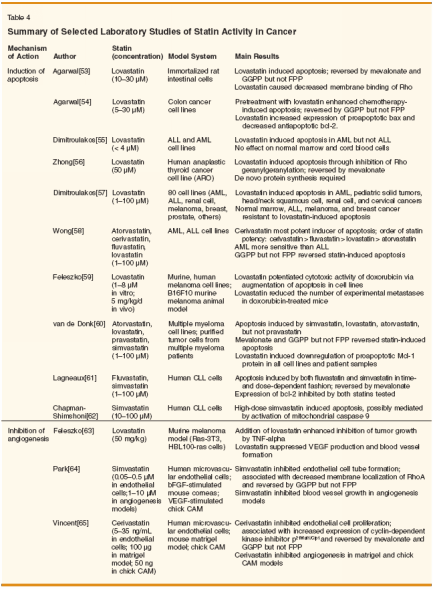
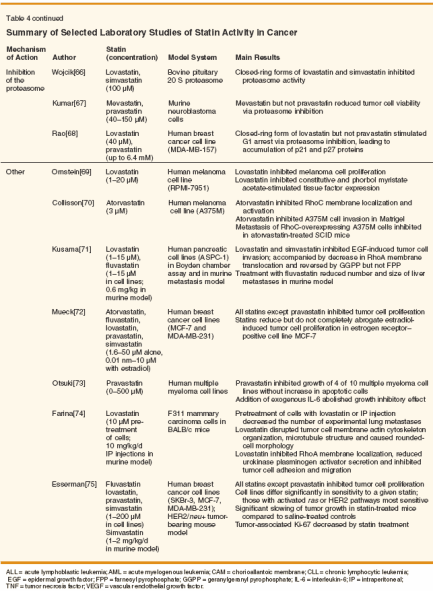
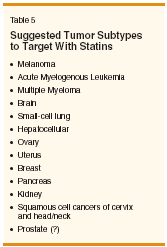
Melanoma represents the ideal tumor type in which to begin testing statins for either of these two applications. Currently accepted adjuvant treatments for high-risk melanoma carry unwanted side effects and are of limited efficacy.[ 98] Furthermore, patients with early-stage disease are at risk for recurrent or new primary tumors, but the risk/benefit equation does not favor administering adjuvant therapy to these individuals who are instead generally relegated to observation strategies. Randomized trials incorporating statins for adjuvant treatment should therefore be undertaken. Chemoprevention efforts with statins in melanoma should target high-risk groups, eg, those in familial atypical multiple mole melanoma (FAMMM) families or with dysplastic nevus syndrome. Other tumor types for which trials of statins as adjuvant treatment could be considered might include AML (eg, after remission induction and consolidation therapy), multiple myeloma (eg, after high-dose chemotherapy and autologous hematopoietic cell rescue), and breast cancer. Treatment with a statin after resection of primary hepatocellular tumors should be studied given the results of the randomized trial in which pravastatin improved survival after embolization and systemic 5-FU treatment.[51] We favor the use of conventional doses of statins given continuously, rather than high doses given intermittently, to best take advantage of their growth inhibitory mechanism of action. Moreover, the combination of statins with cytotoxic or biologic agents holds promise for the treatment of established cancers, given the evidence of synergy in animal models of malignancy.[59,63,96,99] It should not be overlooked that statins may have a role in the treatment of cancer patients beyond controlling tumor growth. For example, their favorable side-effect profile and antithrombotic properties make statins exemplary candidates for testing in thromboprophylaxis trials, and their anti-inflammatory properties might be applied to the control of toxicity due to intensive treatments such as hematopoietic cell transplantation or high-dose cytokine therapy. Which Statin for Which Indication?
Selection of the appropriate statin to test for each cancer indication must be guided by preclinical and clinical data available for specific drugs within the class. Although all statins lower plasma lipids to a certain extent, there are structural and pharmacologic differences that may lead to differences in anticancer activity. For example, the closed ring forms (lovastatin, simvastatin) seem to have a greater effect on proteasome activity than open ring forms.[67,100] Likewise, the statins obtained from fungal fermentation (lovastatin, simvastatin, pravastatin) are generally thought to have the most potent antiproliferative effects.[101,102] Theoretically, the hydrophilic statins such as pravastatin and rosuvastatin might be expected to have less anticancer activity than the lipophilic members of the class due to a decreased ability to enter tumor cells. Although pravastatin has less in vitro activity against breast cancer cell lines than other statins,[ 72,75] it is not clear that this is due to either its hydrophilic nature or its failure to enter the cells. On the other hand, pravastatin has in vitro activity against multiple myeloma cells,[73] is associated with lowering the risk of colorectal cancer,[38] and appears to have significant activity in hepatocellular cancer.[ 51] This further illustrates the point that, similar to conventional cytotoxic drugs, certain drugs of the statin class will likely have activity against some cancers but not others, and underscores the need for prospective trials that are controlled for both statin and tumor type. Since the liver is the intended target organ for statins in their cholesterol- lowering capacity, it has historically mattered little that plasma levels of these drugs are low. Structural modifications that would preserve tumor growth inhibition activity but allow for higher plasma levels and broader tissue distribution would potentially improve the anticancer spectrum of currently available statins. Safety Considerations
Although these drugs are safe in the overwhelming majority of people who take them for lipid-lowering purposes, there are unique issues in cancer patients that may predispose them to untoward toxicity. For example, involvement of the liver with tumor metastases may provoke or exacerbate statin-mediated hepatic injury. Medications that interfere with statin metabolism by cytochrome P450 enzyme pathways, such as erythromycin, azole antifungal agents, and cyclosporine are commonly prescribed to cancer patients and may increase the risk of myopathy or rhabdomyolysis. Care must therefore be taken when combining statins with other drugs, especially chemotherapy agents that might inhibit their clearance by CYP450 enzymes. Ubiquinone has been reported to prevent statin-associated myopathy, but its use in conjunction with statins in cancer patients is yet to be defined. Moreover, although ubiquinone does not appear to interfere with statin-mediated anticancer activity in laboratory models,[103] whether this is the case in humans is not known. Conclusions The statins have been available in the United States for the treatment of hyperlipidemia for nearly 2 decades, but only recently has it been appreciated that these agents have multiple attributes that may be exploited for other purposes including cancer prevention, cancer treatment, and supportive care of oncology patients. A wealth of laboratory data has provided us with plausible mechanisms of action to explain their anticancer effect, and it is now time to accelerate their testing in appropriately designed, hypothesis-driven prospective clinical trials.
Disclosures:
The authors have no significant financial interest or other relationship with the manufacturers of any products or providers of any service mentioned in this article.
References:
1. McKenney J: Pharmacologic characteristics of statins. Clin Cardiol 26 (4 suppl 3):III32- III38, 2003.
2. Cheng-Lai A: Rosuvastatin: A new HMGCoA reductase inhibitor for the treatment of hypercholesterolemia. Heart Dis 5:72-78, 2003.
3. Maron D, Fazio S, Linton M: Current perspectives on statins. Circulation 101:207-214, 2000.
4. McFarlane S, Muniyappa R, Francisco R, et al: Clinical review 145: Pleiotropic effects of statins: Lipid reduction and beyond. J Clin Endocrinol Metab 87:1451-1458, 2002.
5. Veillard N, Mach F: Statins: The new aspirin. Cell Mol Life Sci 59:1771-1786, 2002.
6. Werner N, Nickenig G, Laufs U: Pleiotropic effects of HMG-CoA reductase inhibitors. Basic Res Cardiol 97:105-116, 2002.
7. Blake G, Ridker P: Are statins anti-inflammatory? Curr Control Trials Cardiovasc Med 1:161-165, 2000.
8. Elisaf M, Mikhailidis D: Statins and renal function. Angiology 53:493-502, 2002.
9. Koh K: Effects of statins on vascular wall: Vasomotor function, inflammation and plaque stability. Cardiovasc Res 47:648-657, 2000.
10. Liao J: Statins and ischemic stroke. Atheroscler Suppl 3:21-25, 2002.
11. Libby P, Aikawa M: Effects of statins in reducing thrombotic risk and modulating plaque vulnerability. Clin Cardiol 26(1 suppl 1):I11-I14, 2003.
12. Takemoto M, Liao J: Pleiotropic effects of 3-hydroxy-3methylglutaryl coenzyme A reductase inhibitors. Arterioscler Thromb Vasc Biol 21:1712-1719, 2001.
13. Bauer D: HMG CoA reductase inhibitors and the skeleton: A comprehensive review. Osteoporosis Int 14:273-282, 2003.
14. Austen B, Christodoulou G, Terry J: Relation between cholesterol levels, statins and Alzheimer’s disease in the human population. J Nutr Health Aging 6:377-382, 2002.
15. Chan K, Oza A, Siu L: The statins as anticancer agents. Clin Cancer Res 9:10-19, 2003.
16. Kaushal V, Kohli M, Mehta P, et al: Potential anticancer effects of statins: Fact or fiction? Endothelium 10:49-58, 2003.
17. Casey P, Solski P, Der C, et al: p21 ras is modified by a isoprenoid farnesyl. Proc Natl Acad Sci USA 86:8323-8327, 1989.
18. Jackson S, Ericsson J, Edwards P: Signalling molecules derived from the cholesterol biosynthetic pathway. Subcell Biochem 28:1-21, 1997.
19. Bottorff M, Hansten P: Long-term safety of hepatic hydroxymethyl glutaryl coenzyme A reductase inhibitors. Arch Intern Med 160:2273- 2280, 2000.
20. Ballantyne C, Corsini A, Davidson M, et al: Risk for myopathy with statin therapy in high-risk patients. Arch Intern Med 163:553- 564, 2003.
21. Thompson P, Clarkson P, Karas R: Statinassociated myopathy. JAMA 289:1681-1690, 2003.
22. Newman T, Hulley S: Carcinogenicity of lipid-lowering drugs. JAMA 275:55-60, 1996.
23. MacMahon S: Cholesterol reduction and death from non-coronary causes: Evidence from randomised controlled trials. Aust N Z J Med 24:120-123, 1994.
24. Downs J, Clearfield M, Weis S, et al: Primary prevention of acute coronary events with lovastatin in men and women with average cholesterol levels: Results of AFCAPS/TexCAPS. Air Force/Texas Coronary Atherosclerosis Prevention Study. JAMA 279:1615-22, 1998.
25. ALLHAT Collaborative Research Group: Major outcomes in moderately hypercholesteremic, hypertensive patients randomized to pravastatin vs usual care. JAMA 288:2998-3007, 2002.
26. Sacks F, Pfeffer M, Moye L, et al: The effect on coronary events after myocardial infarction in patients with average cholesterol levels. N Engl J Med 335:1001-1009, 1996.
27. The LIPID Study Group: Long-term effectiveness and safety of pravastatin in 9014 patients with coronary heart disease and average cholesterol concentrations: The LIPID trial follow-up. Lancet 359:1379-1387, 2002.
28. Shepherd J, Blauw G, Murphy M, et al: Pravastatin in elderly individuals at risk of vascular disease (PROSPER): A randomised controlled trial. Lancet 360:1623-1630, 2002.
29. Heart Protection Study Collaborative Group: MRC/BHF heart protection study of cholesterol lowering with simvastatin in 20536 high-risk individuals: A randomized placebo controlled trial. Lancet 360:7-22, 2002.
30. Pedersen T, Wilhelmsen L, Faergeman O, et al: Follow-up study of patients randomized in the Scandinavian Simvastatin Survival Study (4S) of cholesterol lowering. Am J Cardiol 86:257-262, 2000.
31. Pfeffer M, Keech A, Sacks F, et al: Safety and tolerability of pravastatin in long-term clinical trials: Prospective Pravastatin Pooling (PPP) Project. Circulation 105:2341-2346, 2002.
32. Hebert P, Gaziano J, Chan K, et al: Cholesterol lowering with statin drugs, risk of stroke and total mortality. An overview of randomized trials. JAMA 278:313-321, 1997.
33. Bjerre L, LeLorier J: Do statins cause cancer? A meta-analysis of randomized clinical trials. Am J Med 110:716-723, 2001.
34. Blais L, Desgagne A, LeLorier J: 3-hydroxy-3-methylglutaryl coenzyme A reductase inhibitors and the risk of cancer. Arch Intern Med 160:2363-2368, 2000.
35. Graaf M, Beiderbeck A, Egberts A, et al: The risk of cancer in users of statins. J Clin Oncol 22:2388-2394, 2004.
36. Kaye J, Jick H: Statin use and cancer risk in the General Practice Research Database. Br J Cancer 90:635-637, 2004.
37. Ming M, Levy R, Lehrer M, et al: Effect of lipid-lowering drugs on the development of melanoma (abstract 234). Proc Soc Invest Dermatol. Los Angeles, 2002.
38. Poynter J, Rennert G, Bonner J, et al: HMGCoA reductase inhibitors and the risk of colorectal cancer. J Clin Oncol 22:1s, 2004.
39. Cauley J, Zmuda J, Lui L, et al: Lipidlowering drug use and breast cancer in older women: A prospective study. J Womens Health (Larchmt) 12:749-756, 2003.
40. Boudreau D, Gardner J, Malone K, et al: The association between 3-hydroxy-3- methylglutaryl conenzyme A inhibitor use and breast carcinoma risk among postmenopausal women. Cancer 100:2308-2316, 2004.
41. Beck P, Wysowski D, Downey W, et al: Statin use and the risk of breast cancer. J Clin Epidemiol 56:280-285, 2003.
42. Kaye J, Meier C, Walker A, et al: Statin use, hyperlipidaemia, and the risk of breast cancer. Br J Cancer 86:1436-1439, 2002.
43. Coogan P, Rosenberg L, Palmer J, et al: Statin use and the risk of breast and prostate cancer. Epidemiology 13:262-267, 2002.
44. Shannon J, Garzotto M, Palma A: Statin use and prostate cancer risk. J Clin Oncol 22:405s, 2004.
45. Dellavalle R, Schilling L: Do lipid-lowering drugs prevent melanoma? J Invest Dermatol 117:761, 2001.
46. Thibault A, Samid D, Tompkins A, et al: Phase I study of lovastatin, an inhibitor of the mevalonate pathway, in patients with cancer. Clin Cancer Res 2:483-491, 1996.
47. Larner J, Jane J, Laws E, et al: A phase I-II trial of lovastatin for anaplastic astrocytoma and glioblastoma multiforme. Am J Clin Oncol (CCT) 21:579-583, 1998.
48. Kim W, Kim M, Choi H, et al: Phase II study of high-dose lovastatin in patients with advanced gastric adenocarcinoma. Invest New Drugs 19:81-83, 2001.
49. Lopez-Aguilar E, Sepulveda-Vildosola A, Rivera-Marquez H, et al: Security and maximal tolerated doses of fluvastatin in pediatric cancer patients. Arch Med Res 30:128-131, 1999.
50. Minden M, Dimitroulakos J, Nohynek D, et al: Lovastatin induced control of blast cell growth in an elderly patient with acute myeloblastic leukemia. Leuk Lymphoma 40:659-662, 2001.
51. Kawata S, Yamasaki E, Nagase T, et al: Effect of pravastatin on survival in patients with advanced hepatocellular carcinoma. Br J Cancer 84:886-891, 2001.
52. Katz M, Minsky B, Saltz L, et al: Statin use may increase the pathologic complete response rate after neoadjuvant chemoradiation for rectal cancer (abstract 3568). Proc Am Soc Clin Oncol 23:262, 2004.
53. Agarwal B, Halmos B, Feotistov A, et al: Mechanism of lovastatin-induced apoptosis in intestinal epithelial cells. Carcinogenesis 23:521-528, 2002.
54. Agarwal B, Bhendwal S, Halmos B, et al: Lovastatin augments apoptosis induced by chemotherapeutic agents in colon cancer cells. Clin Cancer Res 5:2223-2229, 1999.
55. Dimitroulakos J, Nohynek D, Backway K, et al: Increased sensitivity of acute myeloid leukemias to lovastatin-induced apoptosis. Blood 93:1308-1318, 1999.
56. Zhong W, Wnag C, Chang T, et al: Lovastatin induces apoptosis of anaplastic thyroid cancer cells via inhibition of protein geranylgeranylation and de novo protein synthesis. Endocrinology 144:3852-3859, 2003.
57. Dimitroulakos J, Ye L, Benzaquen M, et al: Differential sensitivity of various pediatric cancers and squamous cell carcinomas to lovastatin-induced apoptosis: Therapeutic implications. Clin Cancer Res 7:158-67, 2001.
58. Wong W-L, Tan M, Xia Z, et al: Cerivastatin triggers tumor-specific apoptosis with higher efficacy than lovastatin. Clin Cancer Res 7:2067-2075, 2001.
59. Feleszko W, Mlynarczuk I, Olszewska D, et al: Lovastatin potentiates antitumor activity of doxorubicin in murine melanoma via an apoptosis-dependent mechanism. Int J Cancer 100:111-118, 2002.
60. van de Donk N, Kamphuis M, van Kessel B, et al: Inhibition of protein geranylgeranylation induces apoptosis in myeloma plasma cells by reducing Mcl-1 protein levels. Blood 102:3354- 3362, 2003.
61. Lagneaux L, Delforge A, Dejeneffe M, et al: Two inhibitors of HMG-CoA reductase, fluvastatin and simvastatin, induce apoptosis of chronic lymmphocytic leukemia cells. Blood 100:381a, 2002.
62. Chapman-Shimshoni D, Yuklea M, Radnay J, et al: Simvastatin induces apoptosis of B-CLL cells by activation of mitochondrial caspase 9. Exp Hematol 31:779-783, 2003.
63. Feleszko W, Balkowiec W, Sieberth E, et al: Lovastatin and tumor necrosis factor alpha exhibit potentiated antitumor effects against Ha-ras-transformed murine tumor via inhibition of tumor-induced angiogenesis. Int J Cancer 81:560-567, 1999.
64. Park H, Kong D, Iruela-Arispe L, et al: 3-hydroxy-3-methylglutaryl coenzyme A reductase inhibitors interfere with angiogenesis by inhibiting the geranylgeranylation of RhoA. Circ Res 91:143-150, 2002.
65. Vincent L, Soria C, Mirshahi F, et al: Cerivastatin, an inhibitor of 3-hydroxy-3-methylglutaryl coenzyme a reductase, inhibits endothelial cell proliferation induced by angiogenic factors in vitro and angiogenesis in in vivo models. Arterioscler Thromb Vasc Biol 22:623-629, 2002.
66. Wojcik C, Bury M, Stoklosa T, et al: Lovastatin and simvastatin are modulators of the proteasome. Int J Biochem Cell Biol 32:957- 965, 2000.
67. Kumar B, Andreatta C, Koustas W, et al: Mevastatin induces degeneration and decreases viability of cAMP-induced differentiated neuroblastoma cells in culture by inhibiting proteasome activity, and mevalonic acid lactone prevents these effects. J Neurosci Res 68:627-635, 2002.
68. Rao S, Porter D, Chen X, et al: Lovastatin-mediated G1 arrest is through inhibition of the proteasome, independent of hydrooxymethyl glutaryl-CoA reductase. Proc Natl Acad Sci USA 96:7797-7802, 1999.
69. Ornstein D, Dixon P, McGlasson D: Lovastatin inhibits tissue factor expression by cultured human melanoma cells-a possible explanation for antineoplastic activity. Thromb Haemost Suppl:P566, 2001.
70. Collisson E, Kleer C, Wu M, et al: Atorvastatin prevents RhoC isoprenylation, invasion, and metastasis in human melanoma cells. Mol Cancer ther 2:941-948, 2003.
71. Kusama T, Mukai M, Iwasaki T, et al: 3- hydroxy-3-methylglutaryl-coenzyme a reductase inhibitors reduce human pancreatic cancer cell invasion and metastasis. Gastroenterology 122:308-317, 2002.
72. Mueck A, Seeger H, Wallwiener D: Effect of statins combined with estradiol on the proliferation of human receptor-positive and receptor-negative breast cancer cells. Menopause 10:332-336, 2003.
73. Otsuki T, Sakaguchi H, Eto M, et al: IL- 6 is a key factor in growth inhibition of human myeloma cells induced by pravastatin, an HMG-CoA reductase inhibitor. Int J Oncol 23:763-768, 2003.
74. Farina H, Bublik D, Alonso D, et al: Lovastatin alters cytoskeleton organization and inhibits experimental metastasis of mammary carcinoma cells. Clin Exp Metastasis 19:551- 559, 2002.
75. Esserman L, Campbell M, Shoemaker M, et al: Breast cancer inhibition by statins. J Clin Oncol 22:97s, 2004.
76. Liao J: Isoprenoids as mediators of the biological effects of statins. J Clin Invest 110:285-288, 2002.
77. Wong W, Dimitroulakos J, Minden M, et al: HMG-CoA reductase inhibitors and the malignant cell: The statin family of drugs as triggers of tumor-specific apoptosis. Leukemia 16:508-519, 2002.
78. Dimmeler S, Aicher A, Vasa M, et al: HMG-CoA reductase inhibitors (statins) increase endothelial progenitor cells via the Pl3-kinase/ Akt pathway. J Clin Invest 108:391-397, 2001.
79. Skaletz-Rorowski A, Lutchman M, Kureishi Y, et al: HMG-CoA reductase inhibitors promote cholesterol-dependent Akt/PKB translocation to membrane domains in endothelial cells. Cardiovasc Res 57:253-264, 2003.
80. Vincent L, Albanese P, Bompais H, et al: Insights in the molecular mechanisms of the anti-angiogenic effect of an inhibitor of 3-hydroxy- 3-methylglutaryl coenzyme A reductase. Thromb Haemost 89:530-537, 2003.
81. Weis M, Heeschen C, Glassford A, et al: Statins have biphasic effects on angiogenesis. Circulation 105:739-745, 2002.
82. Kureishi Y, Luo Z, Shiojima I, et al: The HMG-CoA reductase inhibitor simvastatin activates the protein kinase Akt and promotes angiogenesis in normocholesterolemic animals. Nat Med 6:1004-1010, 2000.
83. Assmus B, Urbich C, Aicher A, et al: HMG-CoA reductase inhibitors reduce senescence and increase proliferation of endothelial progenitor cells via regulation of cell cycle regulatory genes. Circ Res 92:1049-1055, 2003.
84. Urbich C, Dernbach E, Zeiher A, et al: Double-edged role of statins in angiogenesis signaling. Circ Res 90:737-744, 2002.
85. Blann A, Belgore F, Constans J, et al: Plasma vascular endothelial growth factor and its receptor Flt-1 in patients with hyperlipidemia and atherosclerosis and the effects of fluvastatin or fenofibrate. Am J Cardiol 87:1160-1163, 2001.
86. Adams J: Proteasome inhibitors as new anticancer drugs. Curr Opin Oncol 14:628-634, 2002.
87. Ornstein D, Zacharski L: Treatment of cancer with anticoagulants. Int J Hematol 73:157-161, 2001.
88. Zacharski L: Anticoagulants in cancer treatment. Cancer Lett 186:1-9, 2002.
89. Rosenson R, Tangney C: Antiatherothrombotic properties of statins. JAMA 279:1643- 1650, 1998.
90. Splichal J, Stamm J, Ornstein D: The statins: Multifunctional anti-thrombotic and antineoplastic drugs. Semin Thromb Hemost, 2003.
91. Essig M, Nguyen G, Prie D, et al: 3-Hydroxy- 3-methylglutaryl coenzyme A reductase inhibitors increase fibrinolytic activity in rat aortic endothelial cells. Role of geranylgeranylation and Rho proteins. Circ Res 83:683-690, 1998.
92. Bourcier T, Libby P: HMG CoA reductase inhibitors reduce plasminogen activator inhibitor- 1 expression by human vascular smooth muscle and endothelial cells. Arterioscler Thromb Vasc Biol 20:556-562, 2000.
93. Colli S, Eligini S, Lalli M, et al: Vastatins inhibit tissue factor in cultured human macrophages. Arterioscler Thromb Vasc Biol 17:265- 272, 1997.
94. Park H-J, Galper J: 3-Hydroxy-3- methylglutaryl CoA reductase inhibitors upregulate transforming growth factor-b signaling incultured heart cells via inhibition of geranylgeranylation of RhoA GTPase. Proc Natl Acad Sci USA 96:11525-11530, 1999.
95. LaRosa J: Pleiotropic effects of statins and their clinical significance. Am J Cardiol 88:291-293, 2001.
96. Feleszko W, Zagozdzon R, Golab J, et al: Potentiated antitumour effects of cisplatin and lovastatin against MmB16 melanoma in mice. Eur J Cancer 34:406-411, 1998.
97. Shibata M, Kavanaugh C, Shibata E, et al: Comparative effects of lovastatin on mammary and prostate oncogenesis in transgenic mouse models. Carcinogenesis 24:453-459, 2003.
98. Lens M, Dawes M: Interferon alfa therapy for malignant melanoma. J Clin Oncol 20:1818-1825, 2002.
99. Soma M, Baetta R, Renzis MD, et al: In vivo enhanced antitumor activity of carmustine [N,N’-bis(2-chloroethyl)-N-nitrosourea] by simvastatin. Cancer Res 55:597-602, 1995.
100. Efuet E, Keyomarsi K: Novel mechanism of interaction of statins with the proteasome: Implications in breast cancer. Proc Am Assoc Cancer Res 44:713-714, 2003.
101. Corsini A, Maggi F, Catapano A: Pharmacology of the competitive inhibitors of HMGCoA reductase. Pharmacol Res 31:9-27, 1995.
102. Lennernas H, Fager G: Pharmacodynamics and pharmacokinetics of the HMG-CoA reductase inhibitors: Similarities and differences. Clin Pharmacokinet 232:403-425, 1997.
103. Burke L, Lewis L, Perez R: Ubiquinone dose not rescue acute myeloid leukemia cells from growth inhibition by statins. Leukemia 17:267-268, 2003.